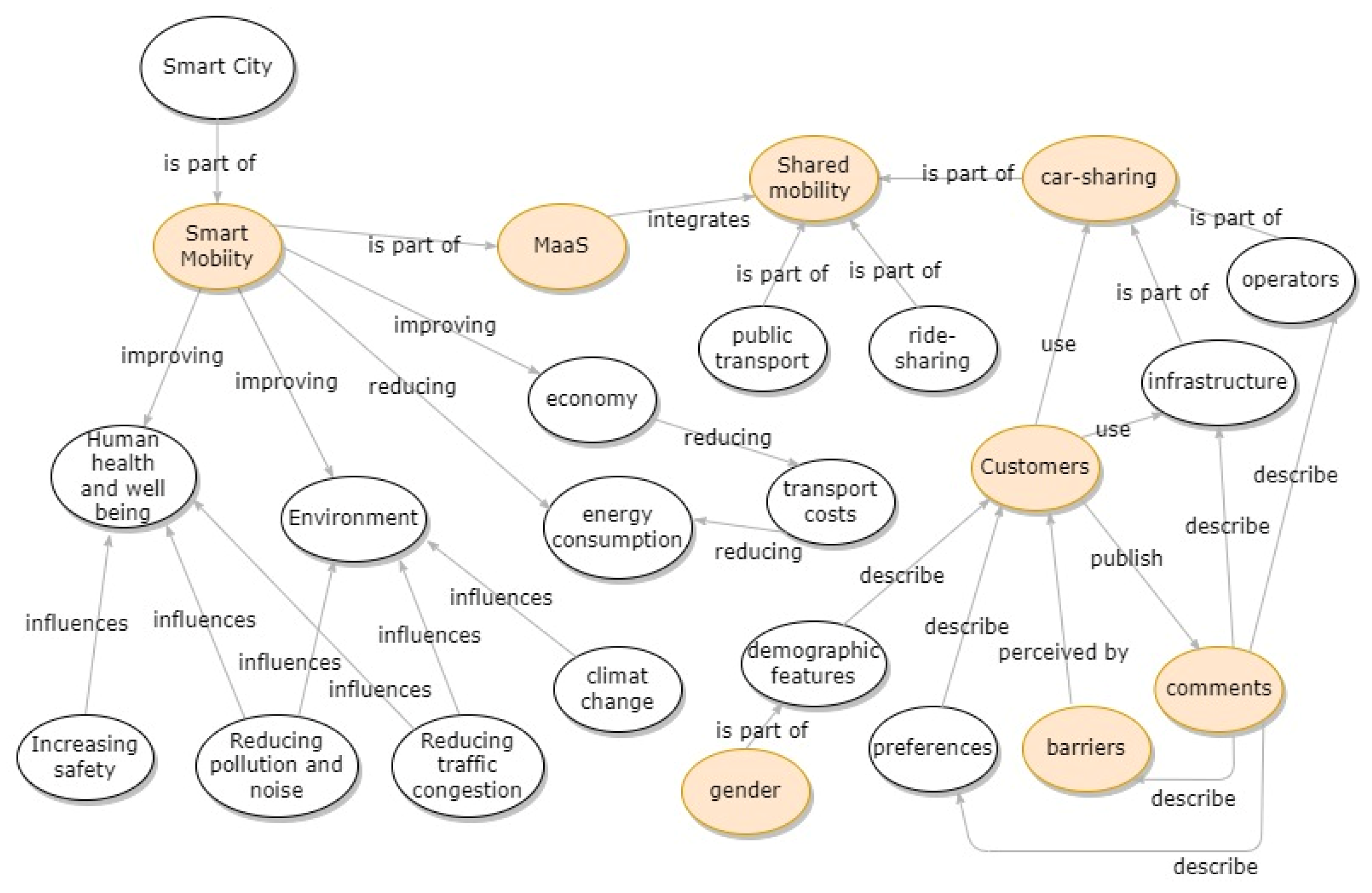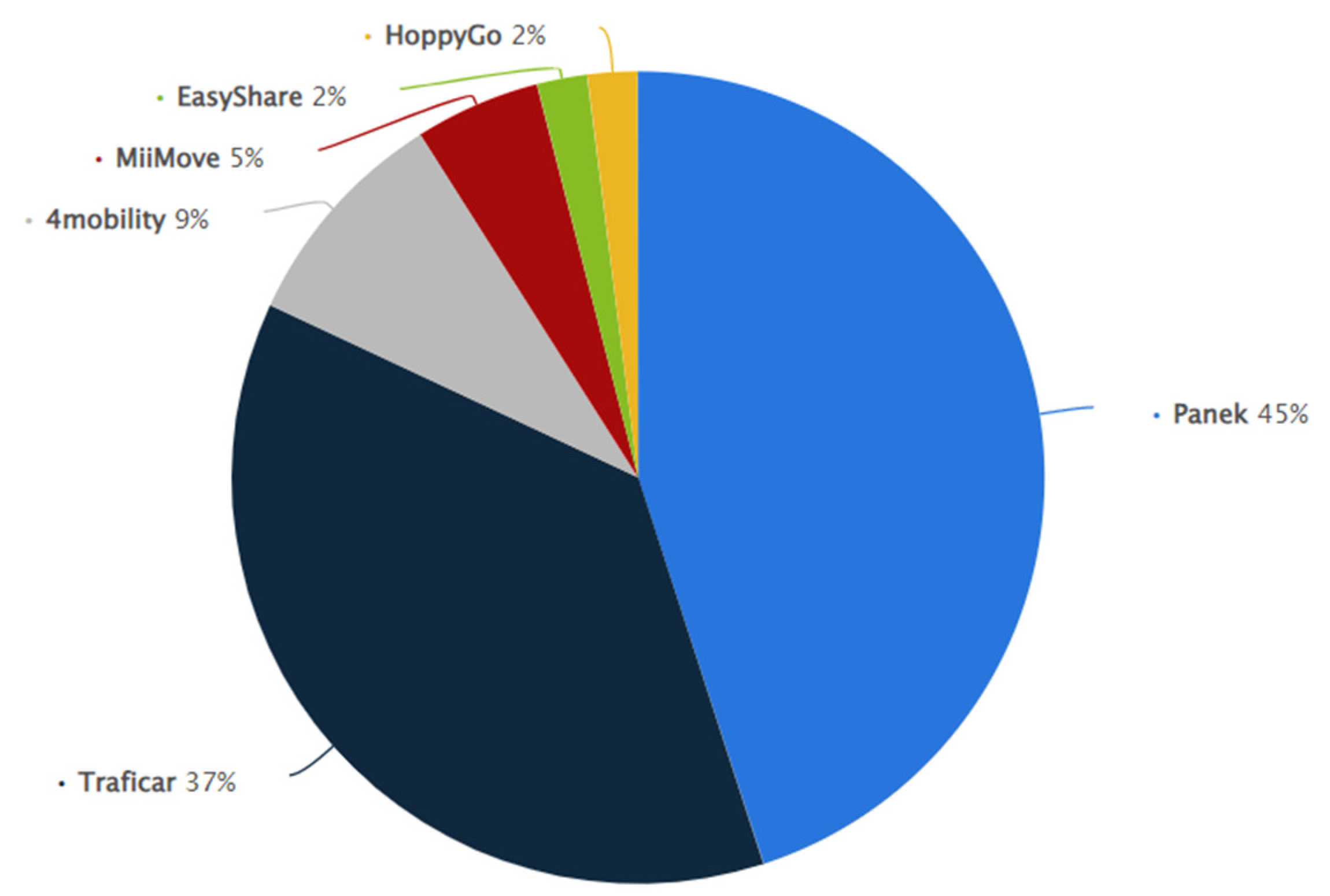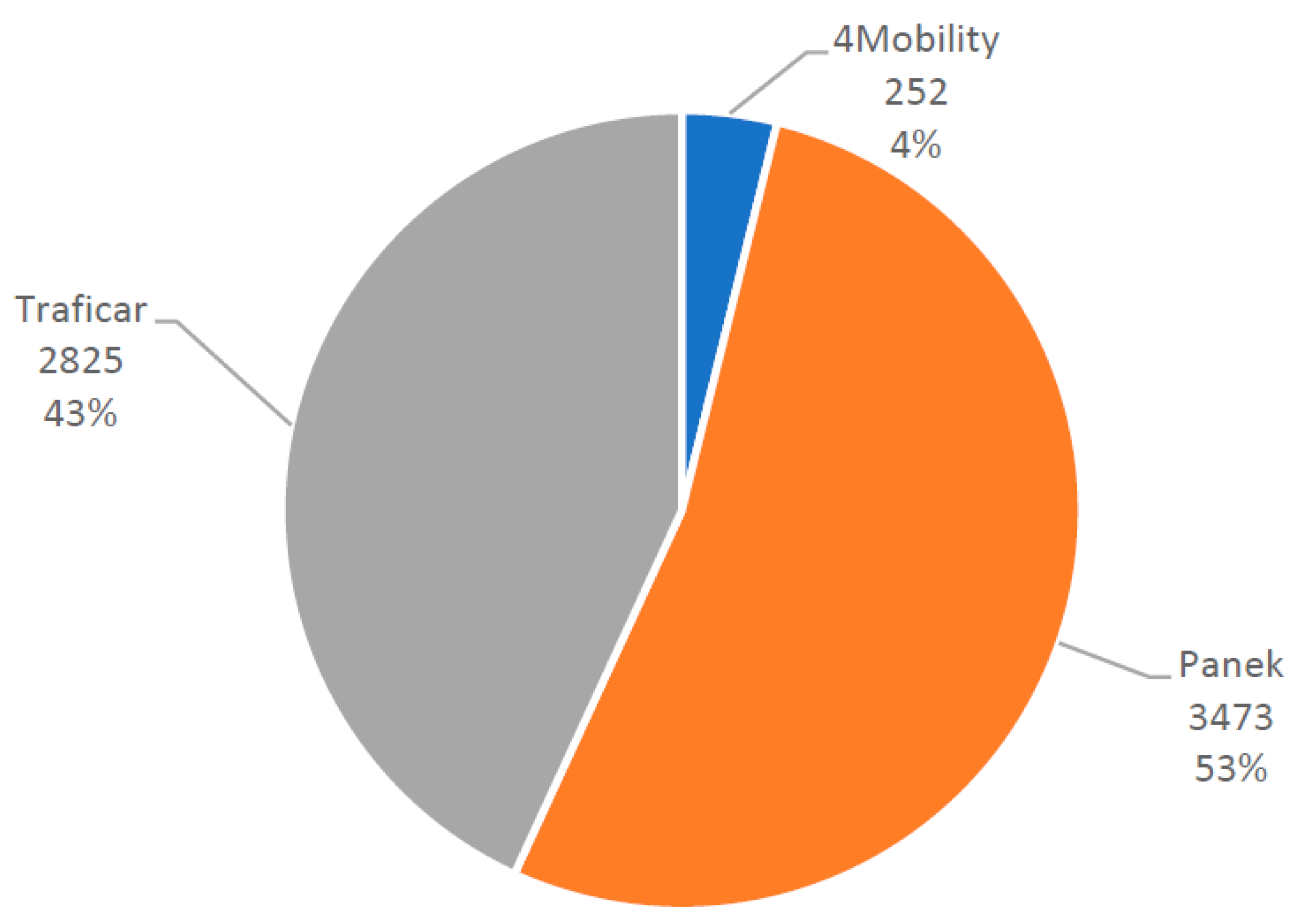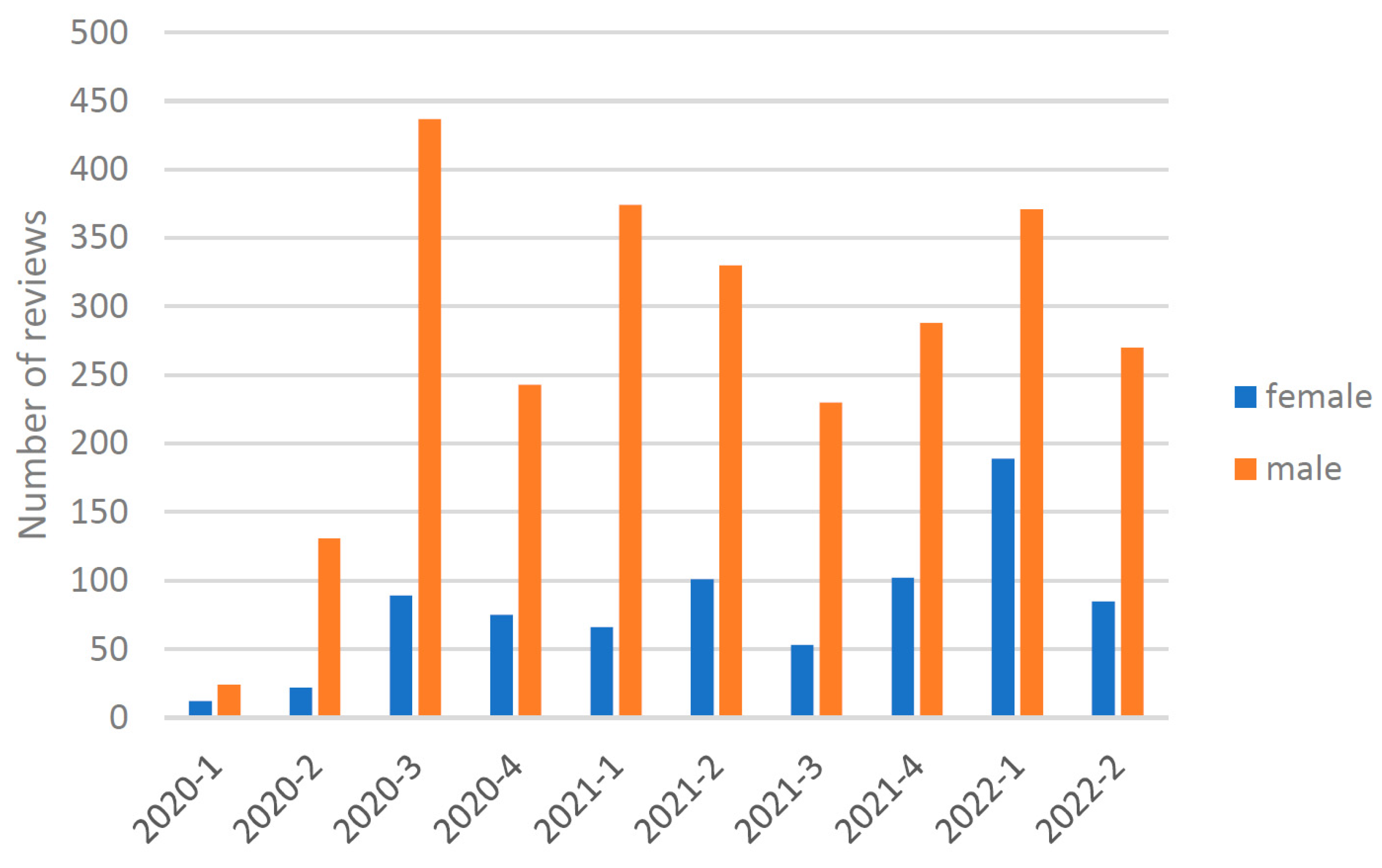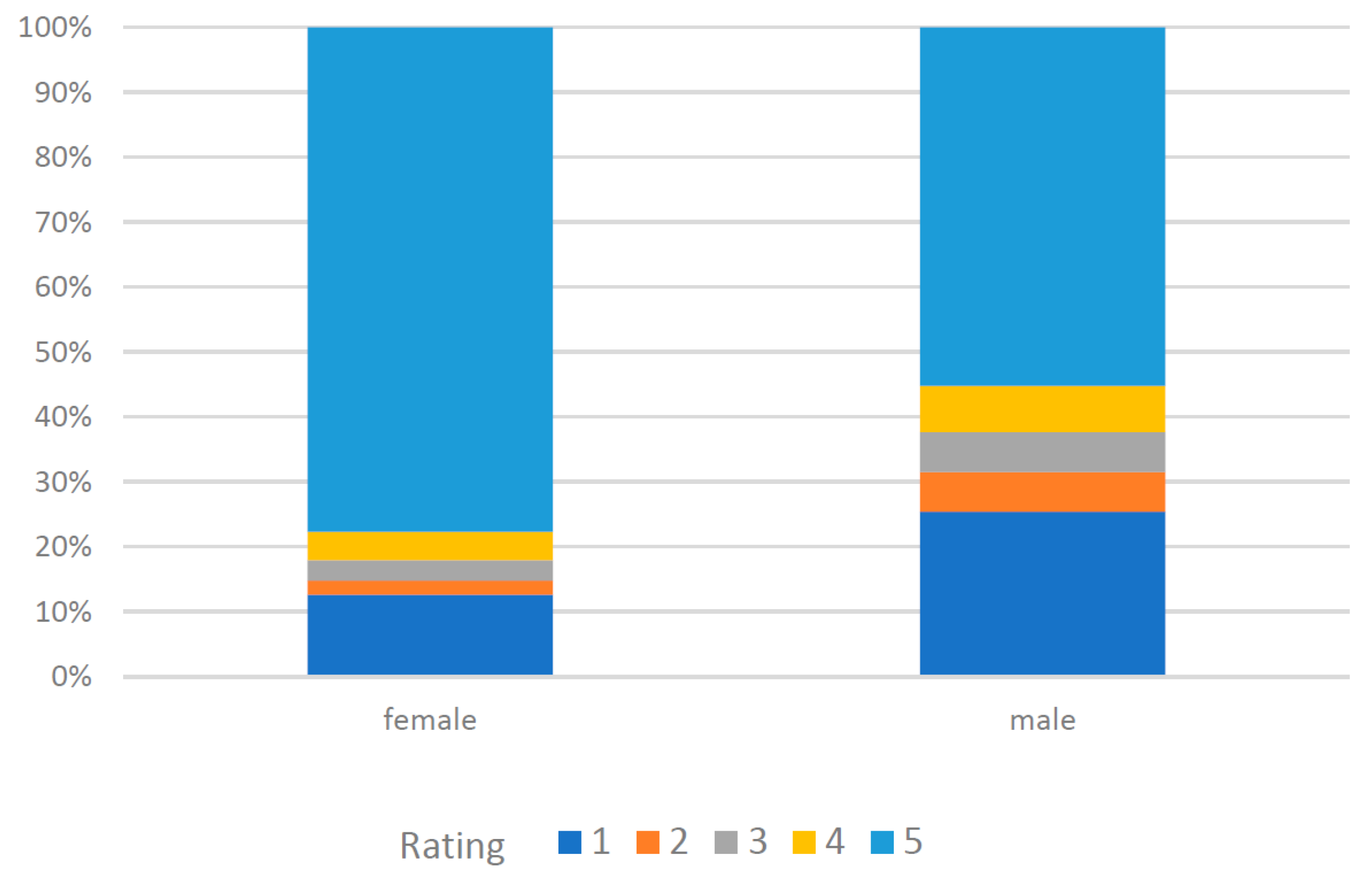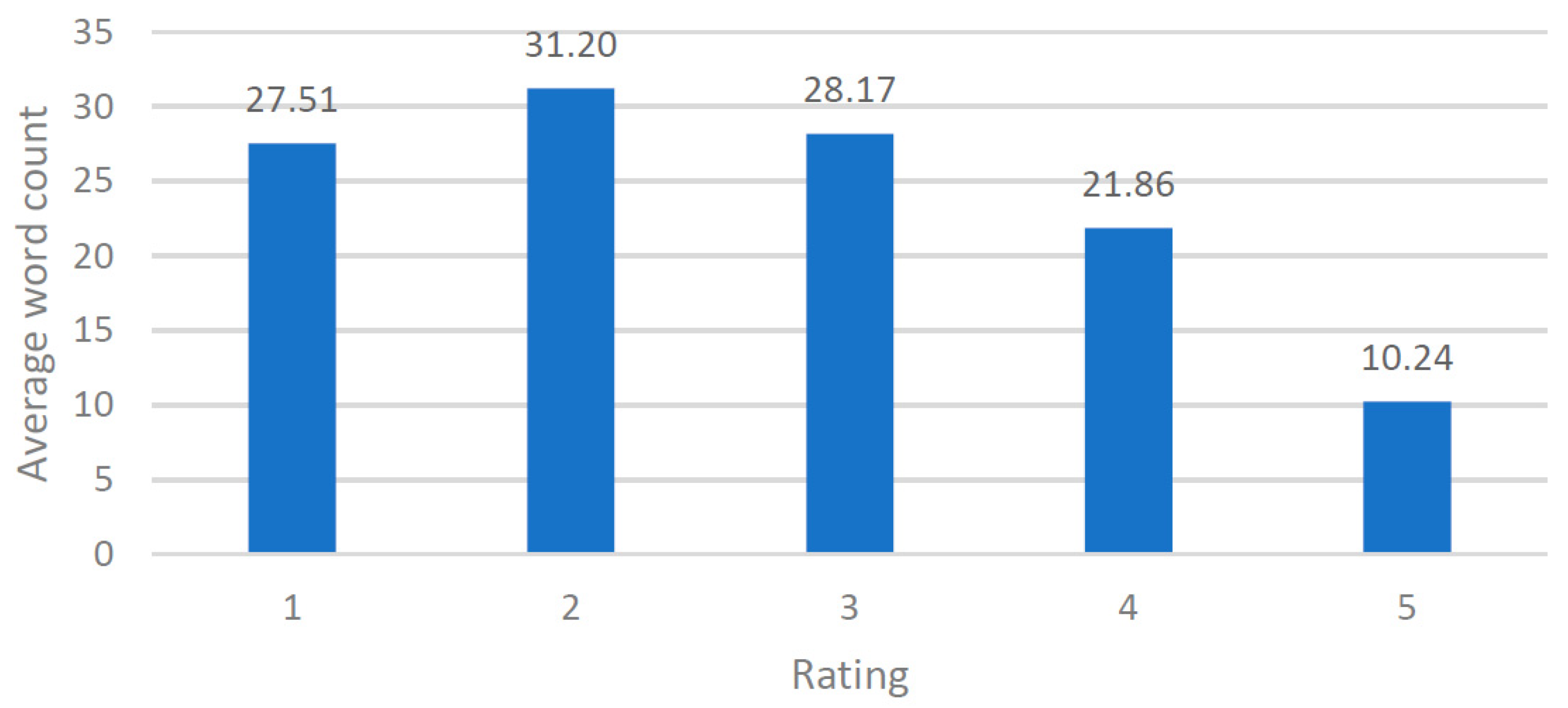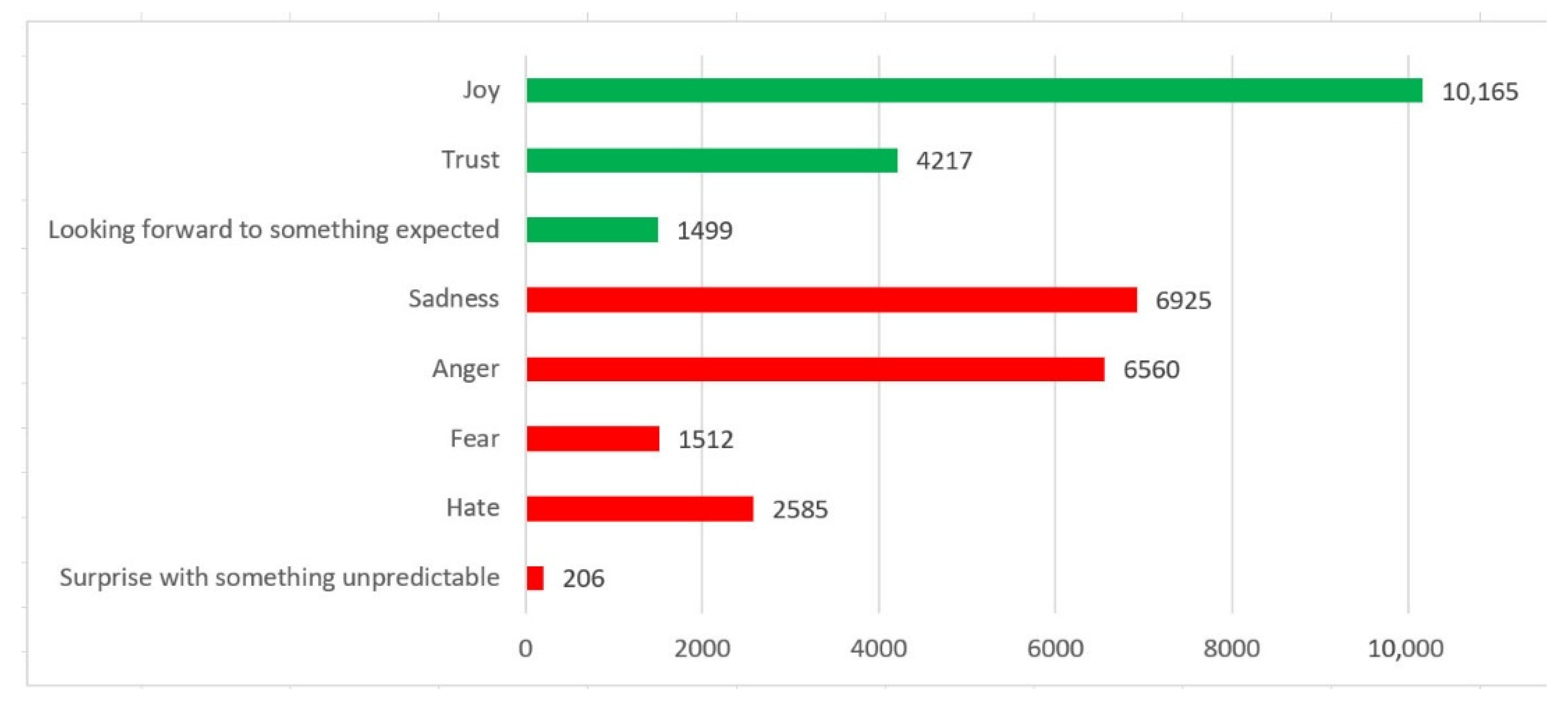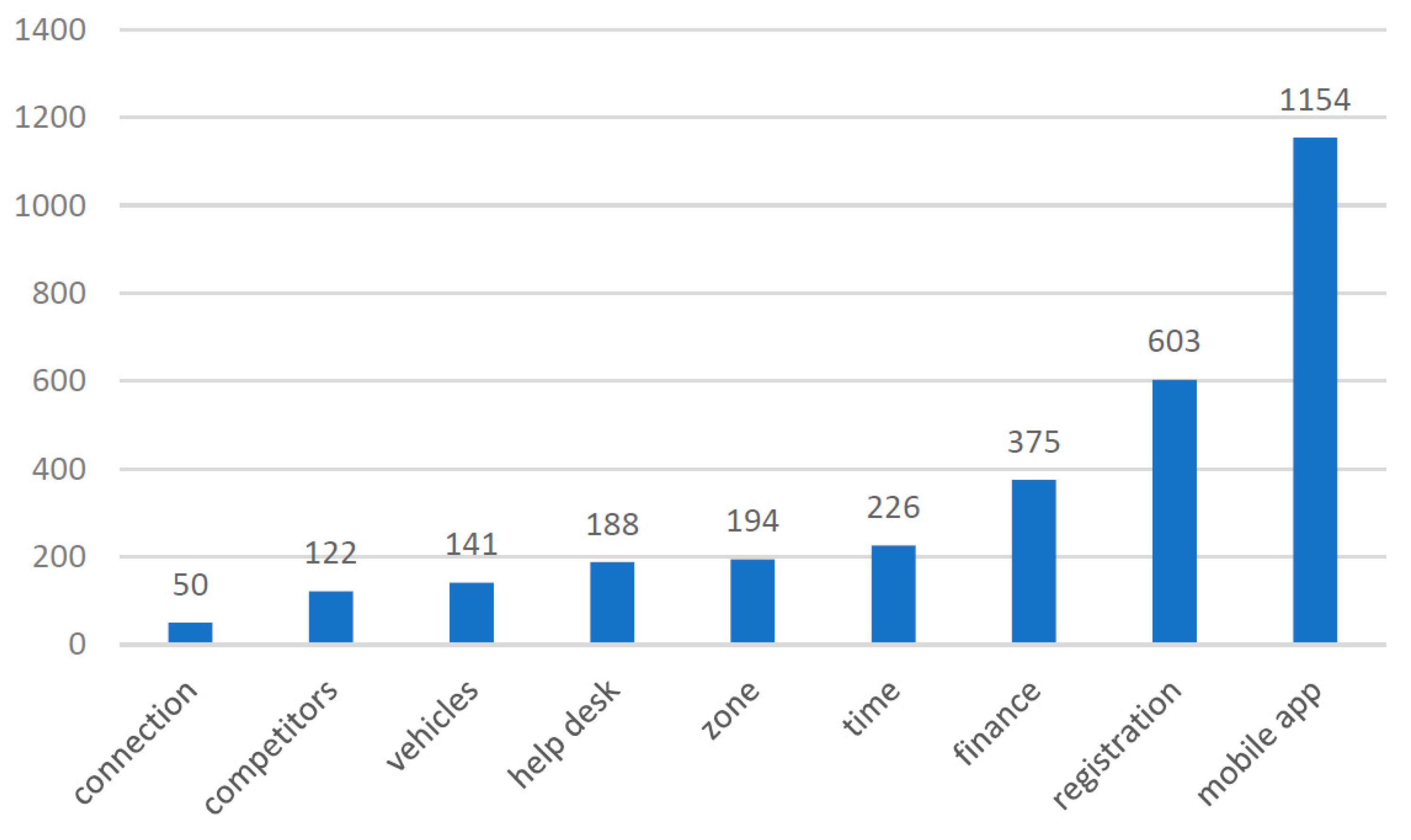1. Introduction
Contemporary cities are complex systems in which many intelligent solutions are used for their inhabitants’ comfort and sustainable development. These solutions connect different types of physical systems, such as vehicles, traffic lights, and buildings, through the Internet of Things technology. One of the essential issues of the smart-city concept is mobility. The premise of smart mobility is reducing empty mileage, and kilometers traveled and alleviating traffic congestion by reducing the number of cars on the roads. Managing the traffic of vehicles in the city is also of great importance in the face of reducing environmental pollution and energy consumption by cars. Integrating intelligent transport solutions at the municipal level is thought to have environmental, economic, and social benefits [
1]. The popularity of mobile applications and wireless access to broadband Internet brings new approaches to urban mobility. This article focuses on car-sharing—one of the answers to inner-city mobility challenges.
The benefits of car-sharing were already recognized two decades ago [
2,
3]. Despite the perceived potential advantages, car-sharing was a marginal phenomenon at these times. Due to the small number of cars, reservations were made manually by contacting the client with a human operator. The customers obtained their vehicle key through a self-service, manually controlled key box, and recorded their own mileage and usage data on paper forms [
4]. In recent years the popularity of mobile applications and wireless access to broadband Internet brings new approaches to urban mobility.
When analyzing the latest publications, it can be noticed that car-sharing’s social, economic, and environmental perspectives have remained the same. The main goals include reducing car ownership [
5], minimizing CO
2 emissions [
6], avoiding costs of car ownership [
7], and striving for equality in access to mobility [
8]. According to a recent study [
9], car-sharing appears to impact the markets for used and new cars significantly.
With so many potential benefits, the idea of car sharing deserves to be spread and encouraged by as many city dwellers as possible. Many authors attempt to examine the factors of car-sharing adoption by describing the user’s profile. Important socio-demographic features here are age and income [
10,
11], as well as behavioral and psychological factors [
12,
13]. Most of the research focuses on the factors contributing to car-sharing adoption among customers with the appropriate socio-demographic profile. However, it is equally important to identify barriers that, if eliminated, could attract new user groups.
The presented exploratory case study aims to identify the problems and barriers of car-sharing in Polish cities from the users’ perspective based on user reviews analysis. The practical objective of the presented research is to highlight the possibilities to improve the identified drawbacks of car-sharing services.
The research material was obtained from Google Play Store by analyzing users’ reviews of the three mobile applications that constitute 91% of the Polish car-sharing market. Descriptive statistics and sentiment analysis were used to extract the main barriers to car-sharing services that can hinder customer experience.
The mobile app is an integral factor in car-sharing adoption, as it provides the only way to interact with the service. Therefore, user reviews can bring valuable knowledge necessary for improving car-sharing companies’ tools and marketing strategies.
Research issues considered in this case study include aspects related to the perception of car-sharing by users. The available data set of the mobile app reviews allowed for identifying emotions related to car-sharing services, problems encountered, and the isolation of descriptive statistics broken down by the users’ gender. An analysis of the data on the usefulness of comments was also carried out.
This paper’s contribution and added value are completing the research gap in the description of the Polish car-sharing market in terms of the main problems and barriers to using car-sharing services perceived by the customers. The research presented in this article may be of interest to companies that provide such services, future investors, and researchers taking up similar topics.
2. Literature Background
The literature referenced in this section aims to highlight the context of the study presented further. Selected recent publications on car-sharing research from the perspective of users are indicated. The choice of publications was dictated by their subject matter and citation rate by other authors. Due to the dynamic development of car-sharing and related applications, up-to-dateness was also a key criterion. The diagram in
Figure 1 aims to place the car-sharing phenomenon in the concept of smart mobility and related research directions. The issues explored in this study are highlighted in the diagram.
One of the earliest car-sharing initiatives started in 1948 in Zurich, Switzerland. It attracted people who could not afford to own a car. More experiments began in the late 1980s, and approximately 200 car-sharing organizations emerged in 450 European cities [
4].
The last 20 years witnessed a shift in the thinking on providing the transport infrastructure required to support the ever-increasing mobility needs of a growing share of the world’s population living in cities and their commuting zones. More often, instead of building additional expensive road capacity, there is more reliance nowadays on using technologies to optimize the performance of existing infrastructure. Rapid ICT development enables the implementation of intelligent mobility frameworks focusing on more efficient road networks and driving behavior [
14]. Smart mobility means modern transport and logistics systems using ICT to enable people and goods to move around in a safe, user and environment-friendly manner as well as efficiently and cost-effectively [
15].
Cities aim to reduce the negative impacts of urban transportation on human health, the environment, and climate change [
16]. Based on the literature analysis, the most critical Smart Mobility goals are presented in
Table 1.
Many transport services are being developed as part of the smart mobility concept. In recent years, Mobility-as-a-Service (MaaS) has attracted much attention in scientific and public debate [
22]. MaaS is a concept where the needs of passengers are met through a single service that combines the offerings of multiple carriers, navigation systems, and payment technologies. One of the components of MaaS is shared mobility, which encompasses transportation services and resources shared among users concurrently or one after another [
23]. Shared mobility includes public transport; micro-mobility (bike-sharing, scooter sharing); microtransit (car-sharing, rides on demand); and vehicle pooling (carpooling and vanpooling). Such services provide collective or individual transport access without owning necessary resources such as cars [
24,
25]. The term shared mobility, therefore, refers to both public and private transport [
26]. Operating MaaS requires a single identity for a traveler to travel with different modes [
27]; therefore, various platforms are implemented to help in seamless trip planning with multiple types of transport. An example of such a platform operating in Poland is the service JakDojade.pl, which uses open data sources [
28]. Monitoring the public transport vehicles’ traffic and GPS coordinates allows optimization of total passenger waiting time and passenger flow.
Car-sharing is increasingly vital in transport [
29]. The sharing economy trend provides favorable conditions for start-ups and investors. Therefore, car-sharing user opinions and behaviors gain much attention from researchers.
The car-sharing services can be an alternative to public transport. However, the impact of car-sharing on public transport seems less substitutional and more complementary [
30]. According to the study [
31] public acceptance and preferences of car sharing depend on generic attributes such as travel time, travel cost, maintenance charges, and membership fees. In addition, several demographic characteristics, such as gender, education, and income, were also found significant. However, the study was limited to one city (Djibouti, Africa), where the phenomenon of car-sharing is relatively new. The observed preferences were much similar to another study from Pakistan [
32] where car-sharing has been a well-established mode of mobility since 2012. Another study from a developing country [
33], apart from the attributes already mentioned, reveals also waiting time and privacy concerns as significant, influential factors in the adoption of car-sharing. These issues are also mentioned by car-sharing users in Poland in their comments, explored in the hereby case study although they are not the primary problem.
Another interesting research perspective regarding the need to popularize car-sharing is the mobility gender gap [
34]. Adopting a gender perspective in research is a way to contribute to gender equality. Studies from different countries reveal that women are under-represented in the car-sharers’ population [
35,
36]. The study [
36] revealed women’s motivations for using a car-sharing service: trust, utility, and safety. Women also tend to be more concerned than men about sustainability issues so they may be attracted to car-sharing due to lower polluting emissions.
A comprehensive characteristic of car-sharing users based on a literature review and survey was presented by [
37]. The study illustrates that males with an upper-middle level salary are the primary users (84%) of the total car-sharing population. Most users are between the ages of 25 and 34; 76% do not have a car. The authors focus on discovering specific demographic characteristics and user behavior, which can set directions for developing car-sharing services according to user needs. However, an important issue that the authors do not address is expanding the market to new users who do not fit the established profile.
The paper closest to this study is [
38], which examines user-generated content related to different car-sharing services in three countries. The analysis unveils 20 determinants of car-sharing quality, which allow for creating car-sharing quality measures. The authors do not provide a detailed diagnosis of the most common problems; however, the paper is a valuable methodological guide to replicate the study in the case of English-language content. The Polish language presents a challenge for computational processing because of the relatively free word order used to stress the importance of information rather than following the rules of grammar. Several written corpora of contemporary Polish have been created, which could be used for automatic topic detection. Still, due to copyright issues, they cannot be freely available for download [
39].
This study attempts to narrow the abovementioned gaps by identifying the main problems and barriers to using car-sharing services.
3. Polish Market of Car-Sharing
The beginning of modern car-sharing services in Poland utilizing mobile applications dates back to October 2016, when Kraków launched the first car-sharing service in Poland. People could rent cars by the minute using a smartphone application for booking vehicles at any time. The application allows users to find the nearest car and unlock it by scanning a QR code on the vehicle. Once they have finished driving, customers can park their cars anywhere within the city limits. Since its introduction in Poland, many car-sharing companies have emerged.
Figure 2 and
Table 2 present Poland’s distribution and characteristics of car-sharing service providers in 2021.
Apart from the many practical advantages of car sharing, it should be emphasized that it also contributes to promoting and disseminating electromobility in Poland. Even though the number of newly registered electric cars powered exclusively by electricity is steadily growing, Poland’s electric car market is still marginal [
41]. The Polish Alternative Fuels Association (PSPA) survey shows that in 2021 every fifth respondent had the opportunity to drive an electric car, which was mainly due to car-sharing companies [
42]. The high purchase price of a new electric vehicle (EV) is regarded as the main barrier to buying an EV over an internal combustion engine (ICE) of the same size. The purchase price, however, does not give the whole picture. Operating costs should also be taken into account. The main obstacle is an upcoming increase in energy prices in 2023, which may question the economic sense of using an electric car.
Currently, there are three players on the market operating in many cities. Two of the smaller companies have probably closed due to the pandemic. Larger companies with more significant development potential remained on the market. It should be noted that the time of sanitary restrictions and general economic collapse, apart from threats, also created opportunities for the development of car-sharing services. During pandemics, traveling by public transport, such as buses or trains, was perceived as one of the main channels of coronavirus transmission and a source of infections. Bus timetables have been limited to the minimum, and the permitted number of passengers has also been reduced. The sale of tickets by drivers had been suspended. This situation resulted in passenger dissatisfaction with trip planning obstacles. During that time, car-sharing had become a convenient and safer solution as long as the car-sharing companies followed the routines of regular cleaning and disinfecting of high-touch surfaces and equipped the cars with personal disinfection kits. The case study in this article does not cover traditional car rental companies. The focus was on free-floating car-sharing services providing their fleet with mobile applications and intelligent spatial algorithms that allow you to locate nearby vehicles and estimate the rental price.
4. Research Methodology
Mobile application stores, such as Google Play, provide a star-rating and commenting mechanism for users to evaluate the apps and leave feedback. User reviews contain valuable information, such as bug reports, feature requests, and user experiences [
43]. The analysis of user comments is a research method that, in recent years, formed a popular and influential field of research [
44]. This method effectively identifies existing technical problems and other sources of customer dissatisfaction. According to the study [
45], approximately 81% of consumers say they’ve left a business review approximately four times a year or less. Therefore it can be assumed that analysis of user comments can provide reliable results. Although it is increasingly common for customers to leave negative reviews about a product, the most common reason to leave a review is that the service or product was excellent (56%). The second most common reason to leave a review is that the product was unsatisfactory (41%) [
34]. Dissatisfied customers are likely to describe their opinions and experiences in more detail. Sentiment analysis and categorizing users’ comments can indicate the directions for improving car-sharing services. The three largest car-sharing companies operating in more than one city and having their own fleet of vehicles were selected for the study. Data on user feedback on car-sharing services in Poland was obtained from Google Play Store.
The research procedure consisted of the following steps:
Gathering comments on the applications of three service providers who operate in more than one city. Comments were extracted from the Google Play store using a Python script and a dedicated library [
46];
Preparation of data for analysis in an Excel spreadsheet. The obtained data structure and the description of the variables are presented in
Table 3;
Feature creation—deriving new features from existing ones. This step involved establishing the sex of the commenting users. The gender of users was determined in several ways (1) based on their first and last names, using a dictionary method. (2) on the basis of the words contained in the comment that may indicate gender. In Polish, it is possible to extract past and future verbs and some adjectives. The text analysis was carried out using a VBA script developed by the author for the project;
Descriptive statistics of the data set for individual numerical and categorical variables;
Application of the CLARIN-PL [
47] sentiment analysis tool for evaluation of the polarity of the comments as positive or negative and also to detect particular emotions accompanying the users of car-sharing services;
Separation of thematic categories by using simple text-processing techniques. Here, the first step was to identify the most frequent phrases in the text that could indicate the subject of the comment;
Counting the number of comments in each category. Each review could have more than one category.
The CLARIN-PL sentiment research tool used in this study extracts words from the text and determines their emotional tone by comparing them with the plWordNet dictionary. plWordNet is a dictionary of negative, neutral, or positive words. The text is then analyzed to see how many negative and positive words it contains. All other statistical calculations and tagging the comments with categories were completed using Excel 2019 (Microsoft Excel 2019 MSO (16.0.10391.20029) (64-bit) Częstochowa Poland. Licenced for Częstochowa University of Technology).
After interpreting the meaning of the dataset fields, the research questions were formulated that guided the study:
RQ1 How the perception of car-sharing services differs in the case of females and males?
RQ2 Which comments are most helpful from the car-sharing users’ point of view?
RQ3 What problems are most often reported by users in comments on mobile applications?
RQ4 How do car-sharing companies approach user comments?
5. Research Results
The examined dataset consisted of 6550 comments from users of three car-sharing applications from October 2016 to June 2022. The descriptive statistics of the variables are presented in
Appendix A.
Figure 3 illustrates the number and percentage of retrieved comments by the operator.
The first issue was to examine the dynamics of the number of comments in individual quarters of the analyzed period (
Figure 4). The dynamic increase in user comments can be observed from the first quarter of 2018. The use of car-sharing services decreased in the first and second quarters of 2020, which is unsurprising as the market’s pandemic crisis was observed at that time. There was a noticeable increase during periods of easing sanitary restrictions, coinciding with the entry of a new market player with an intensive, multichannel marketing campaign.
The dynamics of the development of car-sharing can also be identified to some extent by the application updates. As indicated by the analysis of unique occurrences of the value of the reviewCreatedVersion variable, the surveyed companies have issued 82, 41, and 14 updates, respectively (the youngest company operating since 2020).
5.1. Gender-Based Description of the Dataset
To answer the research question “
RQ1 How the perception of car-sharing services differs in the case of females and males?”, the data set was analyzed in terms of the gender of the commentators. The analysis identified 2955 comments written by men and 824 by women, which is 45 and 13%, respectively. In the case of 2770 (42%) of the comments, the sex of the commentator could not be determined. In the studied case, men are more frequent car-sharing users, which is not surprising, as other studies also confirmed this rule [
35,
36]. Women are under-represented in the population of car-sharers, which implies that the rise in car-sharing is increasing the gender gap in mobility.
The number of comments posted by men and women from the first quarter of 2020 is presented in the chart in
Figure 5. As can be seen, women were in the minority of commentators throughout the analyzed period.
Google Play Store uses the star-rating mechanism, allowing users to rate each app from one star (the lowest) to five stars (the highest). Another issue was examining the ratings given by application users broken down by gender.
The car-sharing app rating statistics were calculated to answer the question “RQ1: How the perception of car-sharing services differs in the case of females and males?”
The mean and median for men were 3.60 and 5, respectively, and for women, 4.32 and 5. A detailed graphical presentation of the differences in the ratings given by men and women is presented in
Figure 6.
It can be noticed that score of 5 predominates among women; it is also the first quartile, while for men, the first quartile is 1.
When analyzing the statistics on the length of comments (variable wordCount), it turns out that statistically, women write shorter reviews. In the case of men, the median and average are 13 and 20.38 words, and in the case of women, 10 and 15.12, respectively.
The chart in
Figure 7 shows that the most extended comments are written by people who rate car-sharing low. They describe their problems in detail, which may hint at improving specific areas of car-sharing companies’ operations. The views of this group of people are analyzed in detail later in this study.
5.2. The Usefulness of Comments
The usability of reviews was also tested. The usefulness of a review is assessed by clicking the thumb icon if users find the review valuable.
Figure 8 summarizes the number of comments on a scale of 1–5 and the number of clicks of the thumb icon.
To answer the research question “RQ2 Which comments are most useful from the car-sharing users’ point of view?” the variable thumbsUpCount was analyzed and broken down by the scores.
It is noticeable that the comments with extreme ratings of 1 and 5 turned out to be the most useful. A significant advantage can be seen in the case of highly negative comments (rating 1). Their number is relatively small, but many people found them helpful.
The content of these comments may be an important source of information for car-sharing companies on how to improve their services. Customer reviews can help to diagnose issues and shed light on possible innovations.
5.3. Sentiment Analysis
To diagnose the problems and barriers faced by users of car-sharing services, sentiment analysis, and semantic analysis were used to distinguish the categories of emerging issues. The sentiment analysis using the CLARIN-PL tool was used to analyze the emotions associated with car-sharing services. All the collected comments were the body of the research. The graph presented in
Figure 9 clearly shows the advantage of positive emotions.
A more detailed analysis with the CLARIN-PL tool allows you to extract phrases relating to positive emotions (such as joy, trust, and looking forward to something unexpected) and negative (sadness, anger, fear, disgust, and negative surprise), as well as positive and negative features. The results of the analysis are presented in
Figure 10 and
Figure 11.
The CLARIN-PL tool also indicated car-sharing services’ positive and negative features detected from users’ reviews (
Figure 11). The most common among the discovered positive features is usability, which may indicate that car-sharing meets users’ needs. The second positive feature is luck. Among the comments highly appreciating the application and service, there are descriptions of situations where the use of car-sharing helped someone a lot in a rush or a breakdown of their car.
The negative features discovered in the corpus of comments often appear as uselessness, misfortune, and harm. The described situations relate to the problem with renting a car, the inability to find or open it, and harm resulting from unexpected charges or not considering the complaint.
Analyzing the comments’ polarity broken down by gender confirms the conclusions from the application rating analysis. In the case of women, negative sentiment covers approximately 27% of the discourse, and in the case of men, 40%.
Figure 12 presents the number of positive and negative emotional occurrences in the text written by women and men.
Sentiment analysis allows you to discover the general emotions accompanying a given phenomenon without more profound insight into the causes. The detailed problem analysis included comments with the lowest ratings—1, 2, and a neutral rating—3. Unfortunately, there is no predefined agreement on the interpretation of star ratings.
To decide whether or not to consider 3-star ratings in this study, sentiment analysis was performed. We found that comments with a rating of 3 contained more negative emotions than positive ones. Therefore, it was decided to include them in the study of car-sharing problem identification because, on the one hand, they indicate issues encountered by users; on the other hand, they contain the most words and therefore describe in detail the reasons for users’ dissatisfaction.
5.4. Car-Sharing Problems Identification
The first step was identifying recurrent topics. For this purpose, the 100 most extended comments sample was selected and analyzed to find the most often occurring words with the help of the tool [
48]. The results were analyzed manually to find the words that indicate problems; this way, 79 keywords were identified and categorized (presented in
Appendix B).
Table 4 shows the categories and subcategories of topics. There is a phenomenon of declension (inflection of a word by cases and numbers) in the Polish language; therefore simple searching method does not give accurate results. To avoid this problem, we used the Morfeusz 2 tool [
49], which extracts morphemes of the words (a part of the word with a recognizable meaning). The corpus of all the comments was searched to find the morphemes and count their occurrences in the text. Topic extraction from the text was made by tagging the reviews according to predefined categories and subcategories.
To answer the research question “
RQ3 What problems are most often reported by users in comments on mobile applications?” the author took a closer look at the reviews with ratings 1, 2, and 3. The analysis covered 2065 comments, 16% did not contain any keywords, and these were often short comments expressing dissatisfaction or emoticons without describing the reason.
Figure 13 presents the summarized number of keywords in each of the nine categories.
In the examined dataset, most keywords were related to the mobile application. The main reasons for dissatisfaction were bugs, post-update issues, and maps.
Co-occurrence analysis of topics was used to determine the keywords often appearing in the same comments.
Figure 14 presents the co-occurrence matrix with data bars. Most reported problems concern the mobile application’s operation with a new user’s registration. This is a critical issue that companies should address first. New users who encounter problems with launching the service at the beginning may become discouraged from using car-sharing.
One of the main goals of social media marketing is building a brand community. Engaging the audience and responding to comments is vital, regardless of whether they’re positive or negative. Recent studies have shown the unavoidable importance of replying to customer reviews [
50]. To answer research question “
RQ4 How do car-sharing companies approach user comments?” the author analyzed the time of companies’ response to the users’ comments.
Car-sharing service providers responded to 63% of user comments. When dividing the data by rating, the structure is very similar. From a marketing point of view, the response time to comments is also necessary. Statistics on companies’ responses are presented in
Table 5.
The statistics on the response delay include only those comments for which the company’s response date was later than the comment was added. In 220 cases, the date of reply was earlier than the comment. These cases were omitted in calculations. Such a situation is possible because the user can change the rating and edit the review at any time. The date of the comment displayed in the Google Play Store is the date it was last revised. If the company does not respond after the review’s edition, the response date is later than the date of the comment submission.
In every case shown in the table, the average value of delay in response is much higher than the median, which means that the distribution is negatively skewed. There are some very high values in the dataset. The descriptive statistics show that, in most cases, the companies reply to the comments in less than one week. They answer 25% of the reviews in 1 or two days, which is a good time. However, the high average values and high values of the third quartiles suggest that the companies do not have a formal policy on standard response time.
6. Discussion and Conclusions
More and more cities in Poland are approaching the Smart City model. Car-sharing services based on modern mobile technologies are only one of the determinants of a smart city. Mobility in growing agglomerations is an essential factor for the development and satisfaction of residents. Problems that arise in the implementation of car-sharing can be diagnosed by analyzing user comments.
The much lower proportion of women in the car-sharers population, visible in the examined sample and other studies, may hint that companies should target their marketing strategies at this social group. Proper feature announcements and product marketing strategies can increase the number of users.
Based on the analysis of comments, the companies can support the pursuit of business goals such as reducing churn by re-engaging users that are unsatisfied with the service and considering switching to a competitor. Here, companies’ responses to reviews of their services play a vital role. It is not only the fact of the replay that counts, but the time it takes to answer it. If the response time is too long, the user may not read it because he has resigned from a given company’s services and has uninstalled the application. As the study has shown, companies’ response time in most cases is up to one week, which is an acceptable value. However, the response rate of several months (indicated by the value of the third quartile) is far too long. According to the author, companies should use sentiment analysis, which will help in the first place to catch emotional comments. They may indicate a high positive or negative commitment of the user. Especially in the case of negative emotions, a quick reaction is necessary to dissuade the client from giving up services or at least mitigate their negative perception of the company and services. It is worth remembering that users can anytime change their rating from a negative to a positive one. In this study, the author observed many cases of rating and comment change after the company response. Facing negative comments is not an easy task, but it does increase self-awareness of shortcomings and see room for improvement. In the author’s opinion, a big plus is an equal care for satisfied and dissatisfied customers. Businesses should pay special attention to responding to comments that many users have found helpful. The author suggests that companies should establish a formal policy on standard response time, considering the sentiment analysis and usefulness of the comments.
As indicated by the sentiment analysis and descriptive data on user ratings and comments, there are more positives concerning car-sharing services. Most customers are enthusiastic about this relatively new phenomenon in Poland. Women perceive services more positively than men, although they are a minority among car-sharing users.
The analysis of the car-sharing problem categories revealed that users often have a problem registering for the service using the mobile application. Registration is the first contact with the company, and successful registration is indispensable to using car-sharing. Advertisements of service providers emphasize the simplicity and speed of renting a car. However, many comments show that first-time application users are already discouraged. Registration procedures should therefore be facilitated. The user verification procedure should take into account different types of documents, including older ones. Another important category of problems is finance, especially payment card verification. Card verification is a purely technical issue that the app’s developers can resolve. However, more financial problems relate to the procedure for settling journeys and too cumbersome handling of complaints. In this area, it is necessary to communicate clear settlement rules to the client in advance.
Users often report the need to extend the zones where they can leave the car at the end of the rental and to improve the precision of the location, in particular excluding private, closed properties and parking lots from the zone.
In the author’s opinion, car-sharing in Poland has excellent development potential, especially in large cities with a limited number of parking spaces and intensive traffic congestion. A factor influencing the increased interest in car-sharing is the rising prices of new cars purchased mainly by companies. The price increase is due to the political and economic situation, including problems in countries supplying parts for car production [
51]. Therefore, the demand for used cars is increasing, which in turn causes their prices to rise. In addition, it is planned to ban to sale of fossil fuel-powered vehicles in the EU from the year 2035 [
52], to withdraw them from the market gradually, and limit the possibility of moving them to certain urban zones. Electric cars, both on the primary and secondary market, are more expensive than internal combustion cars. This situation means that an increasing number of Poles cannot afford to buy a car, and widely available rental companies may be a good alternative.
7. Limitations of the Study and Future Work
The study presented at this moment has several limitations, which determine further research directions. First, the research was limited to the Polish market; thus, conclusions may not be relevant for other countries with different economic systems and digital transformation levels. Therefore, a further direction of studies may be conducting similar research on a sample of respondents from other countries, allowing a comparative analysis on a larger scale. The socio-demographic analysis of car-sharing users would be a very interesting topic; however, investigating application users’ reviews does not provide relevant data. For this purpose, a survey or obtaining data from service providers would be necessary. The latter method can be problematic due to the law protecting personal data and trade secrets. Future works may also concentrate on specific technologies and IT solutions to improve car-sharing services and maintain business continuity during difficult times.
The proposed, easy-to-perform method of comment analysis and problem category identification has advantages and disadvantages. The downside is that you limit your search to keyword morphemes without considering the context. However, the negative context was established based on the comment’s rating (comments rated 1,2, and 3). This approach’s advantage is simplicity and implementation speed, even with a large number of comments. The problem category determination procedure can be implemented with simple VBA scripts or Excel functions, so it can be done without knowing any programming techniques. The method can be improved by providing tools and dictionaries for processing the Polish language. Such tools for the Polish language are dynamically developed. The challenge remains to design a simple interface that non-IT managers could use.
